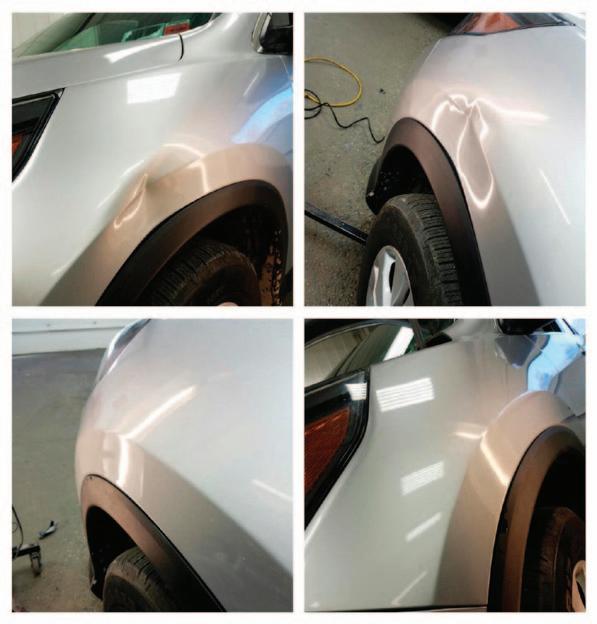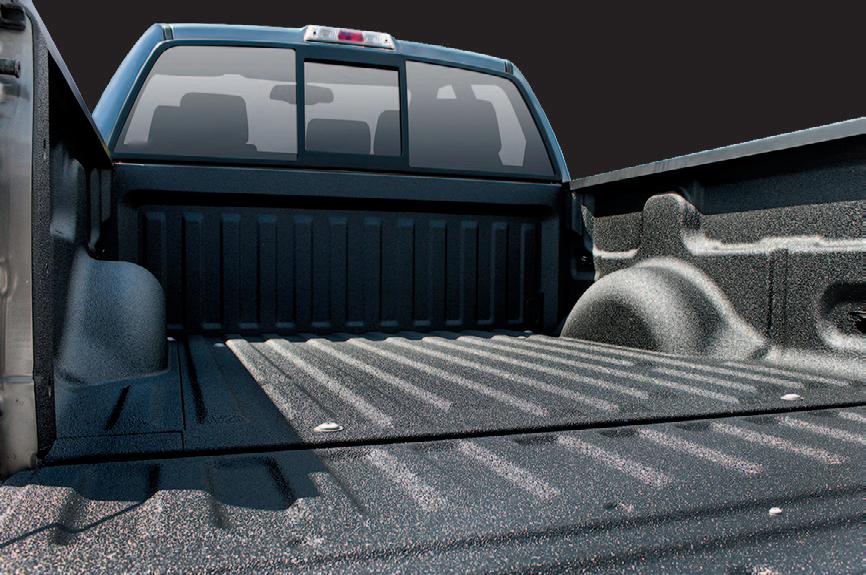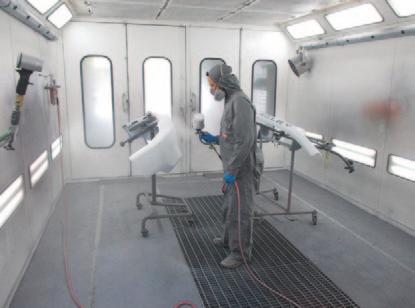
























































































































Road trips remind drivers of just how thrilling the open road can be. For millions of individuals, nothing provides a sense of escapism as effectively as the open road. Though road trips can be liberating, they do not allow a complete escape from reality, something drivers realize when the time comes to fill up the gas tank. Gas prices fell considerably by mid-December 2023, dipping to an average of $3.12 per gallon of regular by the middle of that month according to data from AAA. That marked a significant decline from just a month earlier, when prices for a gallon of regular gas averaged $3.36. But drivers know prices can spike just as quickly as they drop, so it pays dividends to recognize strategies to conserve fuel. Such strategies can be especially beneficial for drivers about to embark on a road trip.
• Slow down. Pushing the pedal to the metal might be a romantic, if unsafe, notion

of how to drive on a road trip. But that approach can be costly at the pump.
According to the U.S. Department of Energy, every five miles per hour motorists drive over 50 miles per hour is the equivalent of paying $0.30 more per gallon of gas. That estimate is based on a gallon of gas costing

$4.32, but drivers can still conserve a considerable amount of fuel by slowing down.
• Steer clear of city driving. The stop-and-go traffic that is a hallmark of city driving can compromise fuel efficiency. The Office of Energy Efficiency & Renewable Energy notes
that rapid acceleration and braking, which is hard to avoid when driving through cities with lots of stoplights and pedestrians, can lower gas mileage by as much as 40 percent.
• Avoid rooftop cargo. Rooftop cargo boxes might be a necessity when a car is packed with passengers. But these luxuries come at a steep cost. A study from the Oak Ridge National Laboratory found that rooftop
cargo boxes can reduce fuel efficiency by as much as 17 percent on the highway and as much as 25 percent on interstates where drivers drive at speeds between 65 and 75 miles per hour. The DOE reports that rear-mount cargo boxes are much more efficient, so drivers looking to conserve fuel may want to pack light and/or opt for rear-mount cargo boxes instead of rooftop boxes.
• Utilize cruise control.
The auto manufacturer Kia estimates that utilizing the cruise control function on a vehicle can save drivers as much as 14 percent on fuel. Cruise control is not advisable when driving in cities or on roads with stoplights. However, when driving on interstates, driving at the same continuous speed helps drivers avoid constant accelerations and decelerations, which compromise fuel efficiency.
When the open road beckons, drivers can make their road trips more affordable by implementing various strategies to conserve fuel.
Road rage is a significant problem on the nation’s roadways. A recent survey from AAA found that 46.6 percent of drivers reported having yelled at another motorist, while 44.5 percent indicated they had honked to show annoyance or anger with another driver. Road rage can be more than just getting a little steamed at the person who cut you off.
AAA reports nearly eight out of 10 drivers demonstrate aggressive driving behaviors while driving. This can result in accidents, including some that are fatal. A report from the advocacy group Everytown for Gun Safety indicated that 2021 was the deadliest year for incidents involving road rage, with an average of 44 people per month shot and killed or wounded during a road rage incident in the United States. Road rage deaths due to gun violence have doubled compared to pre-pandemic levels.






Should you be confronted with road rage, some of the best advice is not to take it personally and escalate the aggression. Always take the humble route and try to de-escalate the situation, particularly if another driver believes you are in the wrong. Mouthing “I’m sorry” may cause the other driver to feel he or she has won and it will diffuse the situation. It’s not about being right or wrong, but getting to a destination safely with no confrontations.













































Drivers can thank the military for the introduction of sport utility vehicles to the mainstream market. Predecessors to modern SUVs date back to military models from the late 1930s, and four-wheel-drive station wagons and other vehicles that were introduced in the late 1940s. However, many car enthusiasts feel the 1984 Jeep Cherokee was the first SUV in the modern style. In 2021, the Environmental Protection Agency reported that SUVs made up 44.67 percent of all light-duty vehicles produced that year, compared to 25.69 percent of market share for sedans and wagons. In fact, as of 2023, many major automakers had announced plans to phase out many of their popular sedans. General Motors dropped nearly all passenger cars from its North American portfolio. Dodge dropped the Challenger and Charger; Acura removed the ILX model; the Chrysler 300 is no more; and Nissan no longer offers the Maxima. These are just some of the effects of the popularity of SUVs and also part of a larger shift toward the production of electric vehicles.
Distracted driving is a significant safety issue. The Centers for Disease Control and Prevention indicates about eight people in the United States are killed in crashes that are attributed to distracted driving every day.
The National Highway Traffic Safety Administration says there were 2,895 distraction-affected fatal crashes in 2019, with distraction-related events accounting for 9 percent of all fatal crashes in the country. Distracted driving also puts Canadians at risk.
Transport Canada’s National Collision Database says distracted driving prevalence rose from 16 percent of fatal collisions in 2006 to 21 percent in 2016, and those numbers are still climbing.
According to the Insurance Information Institute, distractions are a major safety threat. Eating, talking with passengers, adjusting vehicle controls, and using a mobile phone while behind the wheel are activities that take drivers’ attentions away from the road. In fact, distractions are broken down into several categories:
• Visual distractions: Anything that takes one’s eyes off of the road.





• Manual distractions: Anything that takes one’s hands off of the steering wheel.
• Cognitive distractions: Anything that takes one’s mind off of driving.
Drivers can follow these tips to make vehicles distraction-free and reduce the risk for accidents or near misses.
Make adjustments before setting off Make all adjustments to
mirrors, radio stations and seat settings prior to driving. In addition, drivers who intend to utilize a GPS navigation system should enter the address and look ahead at the course before getting on the road.
Keep smartphones out of sight
Reducing the urge to check a phone alert or send a text may come down to out of sight, out of mind. Silence the phone and store it in the glove compartment, center








console or a purse in the back seat. The phone should not be handled until the destination is reached or if the vehicle is pulled over safely out of traffic.
Smartphones have settings that can be programmed to send automatic notifications to people contacting the phone owner to say they’re driving or temporarily unavailable.

Eat before leaving
Consuming food or drink on the road takes a person’s hands off the wheel and eyes off the road. Drivers should try to eat before getting on the road, or pull over to a rest stop for a snack if need be.
Use hands-free devices in emergencies
Many cars come equipped with Bluetooth or other hands-free technology that enables a distress call to be made without having to take hands off the wheel. Many are voice-activated or can be engaged with the push of a button.
Limit passengers
A vehicle full of passengers can be very distracting. It’s why many areas no longer allow newly minted teenage drivers to transport more than a few passengers until they’re older and more experienced. Limiting passengers even for experienced adults can help reduce distractions as well.
People can take steps to reduce distractions on the road and share their advice with others they love.









Drivers about to embark on a search for a new vehicle may experience some sticker shock if it’s been awhile since they purchased a car or truck. According to Kelley Blue Book, the average cost of a new car rose by more than $10,000 between 2019 and 2023, when drivers could expect to spend an average of $47,899 for a new vehicle.
The rising cost of new vehicles may have priced many people out of the new car market. The pre-owned vehicle market has changed considerably over the last decade-plus, so it’s worth considering the many benefits of such automobiles when the time comes to replace an existing car or truck.
• Less sticker shock: Cost
is perhaps the most significant difference between pre-owned and new vehicles. Not unlike new vehicles, the price of a pre-owned car will depend on the category of automobile. However, Carfax® reported that prices for pre-owned vehicles were declining considerably by the end of 2023. By late November of that year, the average cost of a pre-owned SUV was $24,854, while the average price of a pre-owned car was less than $20,000. Those prices are a far cry from the cost of a new car as determined by KBB, making pre-owned vehicles a more budget-friendly option at a point in time when cost of living remains high.
• Less depreciation: Most drivers are familiar with the notion that the value of new cars drops considerably the moment the car is driven off a dealership lot. In fact, the auto insurance experts at Progressive estimate that


many cars lose up to 20 percent of their value within the first year and an additional 15 percent more each year until the four- or
five-year mark. Many preowned vehicles are purchased after the period when their value is dropping considerably each year, which makes some used cars a better investment than a new automobile.
• Lower insurance premiums: Another budgetfriendly benefit of buying pre-owned is that such cars and trucks tend to cost a lot less to insure than new vehicles. Cars cost less to insure as their value goes down, as Progressive notes they tend to be cheaper to repair or replace. The vehicle make and model and how the car is used will determine the cost to insure it, but some estimates suggest pre-owned vehicles can cost as much as 25 percent less to insure than new cars or trucks.










• An altered pre-owned landscape: Used cars declined in popularity as drivers feared being swindled with a lemon. However, the availability of vehicle history reports through firms like Carfax® and the rise in certified preowned vehicles has removed much of the risk once associated with buying used cars. Certified pre-owned programs vary among manufacturers, but most automakers have established standards that ensure vehicles carrying the CPO designation are safe and reliable. The CPO designation is similar, though not exactly the same, as a new vehicle warranty, which can calm drivers’ fears about buying used cars.



Pre-owned vehicles are worth considering when drivers look to replace their existing cars or trucks.











































Headlight glare becomes dangerous when visibility is impaired to a point where the risk of accidents is heightened. Glare is a growing problem for many modern drivers due to the increased use of light emitting diodes in headlights.
Driving at night is challenging because pedestrians, cars and other obstacles are difficult to see once the sun sets. However, a study from the U.S. Department of Transportation found that 88 percent of drivers noticed LED and HID headlight glare, with more than 30 percent saying the glare is “disturbing.” While LED lights may not actually be brighter, their “cool” spectrum make them appear so. Studies have found that blue and white light tends to hit people’ s eyes harder, especially at night.
In addition, human eyes do not adjust to changes in lighting very quickly, according to Pierre Paul Driving School in New
York. The older a person gets, the longer his or her eyes will take to adjust to changes in lighting. In fact, it can take up to seven seconds to recover from the blinding glare of headlights. That’s enough blindness to swerve off the road or potentially hit something.
While glare can be problematic, drivers can take certain steps to make it safer to drive at night.
• Clean the windshield. Dirt and grime found on the windshield can refract light and make glare worse. Therefore, clean all windows and mirrors thoroughly, inside and out.
• Repair scratches and cracks. Glare can be exacerbated by any imperfections in the windshield. Repair cracks or scratches promptly.
• Get a vision and health check. Changes to vision can impact how glare affects certain individuals. Vitamin A deficiency can cause night blindness, also known as nyctalopia. Eye shape changes, including a condition called keratoconus, can affect vision. Cataracts and diabetes also impair vision. Visit with a primary care physician as well as an
eye doctor to diagnose conditions that can make night vision worse.
• Change your line of sight. Do not look directly into oncoming headlights. Rather, look slightly down and to the right side of the road so that you’re not focusing on the beams.
• Get glare-resistant coatings on eyeglasses. Speak with an optician about eyeglasses with anti-glare coating. This will significantly reduce the amount of glare. VisionCenters.com says standard plastic lenses reflect around 8 percent of the light that reaches glasses, while high-index lenses reflect up to 12 percent of available light. Anti-glare coating allows 99.5 percent of available light to reach the eyes, essentially eliminating glare. Those who don’t wear eyeglasses can purchase specific anti-glare glasses to wear in high-glare conditions.
• Flip the rearview mirror to “night” mode. This will make it appear as though lights coming from behind are dimmer.
These are some of the steps to take when glare becomes problematic while driving at night.
To be confident of your decisions about car insurance, here are three of the most frequently asked questions and answers.
1. How can I make sure I have “full coverage”?
Generally, people ask for “full coverage” when they want more than just what’s required by the state. Most states require that all drivers carry liability coverage, which pays for damage to other vehicles or injuries to other people that you cause.
By adding what is commonly referred to as
“physical damage” coverages, which include comprehensive and collision insurance, damage to your own vehicle is also covered.
Once you’ve chosen these coverages, you might also want to add insurance that will cover your medical payments, protect you if you’re hit by an uninsured driver or come to the rescue if you break down on the side of the road.
2. If I get into a fender bender when driving a rental car, would it be covered under my car insurance?
Generally, if you have liability and physical damage coverages on your car insurance policy, there’s a good chance you’ll be covered in a rental car. Call your agent or insurance
company to get the facts before you turn down that extra coverage. Another option: Check with your credit card company. Some credit cards provide coverage at no charge if you use their card to pay for the rental.
3. A friend just borrowed my car. Will my car insurance pay for the damages if he causes an accident? In most states, insurance coverage follows the car. Two things to keep in mind: If the cost to repair that damage exceeds the amount allowed by your policy, your friend may need to make a claim on his insurance to pay the difference; and, secondly, your rate may go up as a result of the claim.















































For many Americans, their vehicle (be it a car, truck or SUV), is an important part of how they live their daily lives. It connects them with school, work, shopping, family and friends.
At the same time, these vehicles are a major source of emissions that contribute to greenhouse gas and climate change. Fortunately, there are many ways in which consumers can reduce the amount of pollution that their vehicles generate and save money at the same time.
The Environmental Protection Agency’s (EPA) SmartWay program offers the following tips and suggestions for reducing the impact that your vehicle has on the environment:
Buy Smart
Use the EPA’s Green Vehicle Guide as a resource in selecting your next
compact car, midsize sedan, or sport utility vehicle. The guide provides air pollution scores and greenhouse gas scores for all vehicles. The higher the scores, the better it is for the environment. Compare the scores of different vehicles or just look for the SmartWay certification mark to find the superior environmental performers. You may be surprised to find that even if you need a larger vehicle, you have cleaner choices. The better the fuel economy, the more money you’ll save at the pump, while also reducing the nation’s dependence on oil.
Drive Smart
• Be aware of your speed. Obeying highway speed limits can save fuel as well as prevent pollution.
• Avoid rapid accelerations and braking, which burn more fuel.
• Use cruise control and overdrive gears.
• When you aren’t in



traffic, turn off the engine rather than idle for more than 30 seconds.
• Remove excess weight from your trunk, and if you have a removable roof rack and aren’t using it, take it off. Take Care Of Your Vehicle
• Your vehicle is designed to perform best when maintained according to the instructions found in the owner’s manual. A poorly maintained vehicle can be more polluting and less fuel efficient than one that’s well maintained.
• Keep your tires properly inflated. Low tire pressure means lower fuel economy.
• Replace your air filter regularly. A clogged air filter can reduce fuel economy significantly.
Use Your Vehicle Less
• When possible, combine activities and errands into one trip.
• Take advantage of public transportation and carpooling.
• Bicycling or even walking can be a suitable (and healthy) transportation alternative.




sitting in the driveway or cruising the highway. However, regular car washes are more than cosmetic.
which can help it look good while
• Protection from the sun: A car that is routinely and properly washed and waxed is less vulnerable to damage from the sun’s ultraviolet rays.
who live near the ocean or in areas where roads are salted in the winter to melt snow may have cars with high salt corrosion rates. Unless it’s washed off frequently, salt can take its toll, leading to damage.


• Extend the life of paint: Dirt and debris can build up on the paint surface and eventually lead to scratches and other damage. Bird droppings and sap can be corrosive. Washing will help remove grime and protect the paint in the process.
• Preserve the vehicle’s value: Drivers who plan to sell or trade in their vehicles in the future should realize that a well-maintained car can bring in as much as 20 percent more for above-average condition, according to Kelley Blue Book. Maintaining a clean and shiny vehicle can protect its long-term value.
• Remove salt: Drivers
• Improve fuel efficiency: Drivers have felt pain in their wallets at the fuel pump in recent years. Dirty cars may be less aerodynamic and less fuel-efficient as a result. Keeping a car clean may improve its fuel efficiency.
• Maintain the interior: Car washes are not only about the exterior. Keeping a clean and tidy interior can help improve the air quality inside of the vehicle and prolong the life of upholstery, mats and interior components. Car washes should be a routine part of vehicle maintenance. Professional car washes tend to be more eco-friendly than washing a car at home, so drivers are urged to investigate their service plans and features.




















Electric vehicles are increasingly visible on roadways around the world. According to BloombergNEF, a strategic research provider covering global commodity markets, in June 2022 there were 20 million plug-in vehicles in use across the globe. That’s an increase from only one million in 2016. As more people are drawn to EVs, drivers can exercise due diligence to learn more about them, particularly if they’re considering buying their first such vehicle.
Different Vehicle Types
The term “electric vehicle” encompasses a variety of cars and trucks. The following are some common categories.
• Hybrid electric vehicle: These are the most common type of hybrids. They have two power drives, which include a fuel-based engine and an electric motor with a larger battery. A computer determines when electricity or gas should be used. The system utilizes regenerative braking that ensures the electric battery gets a little recharge every time the driver touches the breaks
• Mild hybrid electric
vehicle: MHEVs use a battery and electric motor to increase the efficiency of an internal combustion engine (ICE). An MHEV does not run solely on electric power, but the ICE can be turned off and the electric motor used while braking, coasting and stopping.
• Battery electric vehicle: BEVs are powered entirely by electricity and will have no ICE or fuel tank. Users charge the battery using an electrical outlet.
• Plug-in hybrid electric vehicle: Like BEVs, PHEVs have an electric motor that is charged by plugging it in. They also have a fuel-based ICE like HEVs. Where they differ is that PHEVs can travel a considerable distance on electric power alone, while HEVs cannot.
Driving Range
The distance EVs can travel before needing to recharge depends on the type of vehicle. Most EVs have a driving range between 50 and 330 miles. Shoppers should determine the “range-per-charge” for the vehicle to assess if it




will fit their driving needs and daily commutes. Drivers who frequently take long road trips may have to assess if a hybrid vehicle is more practical; otherwise, careful planning may be necessary to accommodate charging along the route.
Individuals who live in private homes or rentals with access to outlets may be more inclined to invest in EVs. Charging can be done with a standard 120V outlet, but it will increase



charging time considerably. Many people opt to have a 240V charger installed in a garage or driveway, which is known as “Level 2 ESVE equipment.” With this type of setup, a charge can be reached in roughy four to 6 six hours, says Valley Clean

Energy. Public charging stations utilize a 480V input and can charge many EV models in about 20 to 30 minutes. Plug-in hybrid vehicles do not typically have fast charging capabilities, however.
Reduce Maintenance
BEVs require less maintenance than conventional vehicles because there are fewer fluids like oil and transmission fluid to change, and far fewer moving parts. EVs require minimal scheduled maintenance to electrical systems, including the battery and electrical motor. Hybrid vehicles still require the standard maintenance of gas-powered vehicles.
EVs are growing in popularity, so potential buyers can school themselves on these newer vehicles to determine if they’re the right fit for them.













The cost of owning a vehicle has risen dramatically in recent years. Though prices at the gas pump have done much to stretch drivers’ budgets, supply shortages related to the COVID-19 pandemic hit motorists’ bottom lines even before the average gallon of gas reached unimaginable levels in mid-2022. Though it’s certainly not an inexpensive time to own a vehicle, drivers can take solace knowing that these four basic vehicle maintenance tasks can be performed at home and save them money.
1. Change air filter: Among the simplest DIY vehicle maintenance tasks, changing the air filter on a car or truck requires no special tools. Changing an air filter can be done in as little as 10 minutes, though novices might need more time until


they get a feel for what’s under the hood. Vehicle owners’ manuals can indicate where the air filter is
and how frequently it should be replaced.
franchises exceeded $75 in May 2022. But this relatively simple task can be performed at home rather easily. Drivers will need to invest in a ratchet, oil filter wrench, oil pan, and funnel, but that’s all they need to change their own vehicle oil. A jack will be necessary as well, but most new vehicles already come with a jack.
Drivers who aren’t fond of taking their vehicles in for routine oil changes may want to consider electric vehicles. According to Kia, electric vehicles, or EVs, do not require oil. Oil is necessary to lubricate the various moving parts in combustion engines. Manufacturers advise drivers to get oil changes around every 5,000 miles or every six months, whichever comes first. No such maintenance is required with EVs because they consume batteries while running on electric motors.

4. Tire inflation: Drivers can save on that costly fuel by keeping their tires properly inflated at all times. Poorly inflated tires make the engine work harder to get the vehicle down the road, and that extra work wastes fuel. A portable tire inflator can read the pressure in each tire and drivers can then inflate the tires to the PSI recommended in their owner’s manual. A quality tire inflator can be purchased for less than $100.
time it takes to perform this task could depend on how long it takes to remove the old blades, which can take time until DIYers get a handle on how to quickly remove them.
















































































































































2. Change wiper blades: Changing wiper blades is another simple DIY task that doesn’t require any special tools. Streaking is a telltale sign blades should be replaced, and some blades even start to come apart after excessive wear and tear. The
3. Oil change: According to Bankrate.com, the average cost of a top service oil change at six nationwide





Novices may be overcome by nerves when attempting these jobs for the first time, but online tutorials can help them get a handle on any task that stretches their abilities to the limit. If the task seems too tall to tackle at home, take the car to a trusted mechanic or dealership.
EV drivers will have to monitor certain fluids, though. Coolant is necessary to prevent batteries from overheating, and that can be periodically during routine maintenance performed at an auto body shop. Drivers also can monitor and refill windshield washer fluid as necessary. Brake fluid in EV cars also needs to be replaced periodically, and Kia notes that its EVs need fresh brake fluid after running about 25,000 miles.








































































